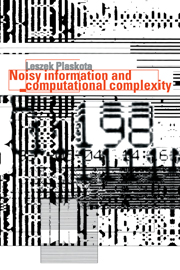3 - Average case setting
Published online by Cambridge University Press: 13 January 2010
Summary
Introduction
This chapter deals with the average case setting. In this setting, we are interested in the average error and cost of algorithms. The structure of this chapter is similar to that of the previous chapter. That is, we first deal with optimal algorithms, then we analyze the optimal information, and finally, we present some complexity results.
To study the average error and/or cost, we have to replace the deterministic assumptions of the worst case setting by stochastic assumptions. That is, we assume some probability distribution µ on the space F of problem elements as well as some distribution of the information noise. The latter means that information is corrupted by random noise. Basically, we consider Gaussian distributions (measures) which seem to be most natural and are most often used in modeling.
In Section 3.2, we give a general formulation of the average case setting. We also introduce the concept of the (average) radius of information which, as in the worst case, provides a sharp lower bound on the (average) error of algorithms.
Then we pass to linear problems with Gaussian measures. These are problems where the solution operator is linear, µ is a Gaussian measure, and information is linear with Gaussian noise. In Section 3.3, we recall the definition of a Gaussian measure on a Banach space, listing some important properties. In Sections 3.4 to 3.6 we study optimal algorithms.
- Type
- Chapter
- Information
- Noisy Information and Computational Complexity , pp. 121 - 214Publisher: Cambridge University PressPrint publication year: 1996



